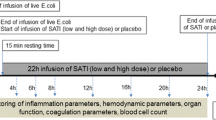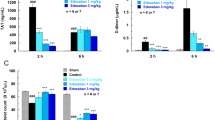Abstract
Objective
We examined the role of coagulation and fibrinolysis in lipopolysaccharide (LPS) induced disseminated intravascular coagulation (DIC) in rats, studying their contribution to fibrin deposition and organ failure in rats with LPS-induced DIC by concurrent administration of low molecular weight heparin (LMWH) with or without tranexamic acid (TA).
Methods
DIC was induced in male Wistar rats by a 4-h infusion of LPS (30 mg/kg) via the tail vein (LPS group). In the LPS+LMWH group LMWH (200u/kg) was administered to rats from 30 min before the infusion of LPS for 4.5 h. In the LPS+LMWH+TA group LMWH (200 µg/kg) and TA (50 mg/kg) were administered to rats from 30 min before the infusion of LPS for 4.5 h.
Results
In the LPS+LMWH group lower plasma levels of TAT, D dimer, creatinine, and alanine aminotransferase were observed, along with less glomerular fibrin deposition and improved survival over rats administered LPS alone. However, these effects of LMWH were completely eliminated and damage beyond that observed in rats administered LPS alone resulted from combined administration of TA (LPS+LMWH+TA group), except that TAT and D dimer levels remained lower than in the group administered LPS alone.
Conclusions
Suppression of fibrinolysis by TA (despite coadministration of LMWH) resulted in increased organ damage in this study, suggesting that depressed fibrinolysis plays a large role in organ failure resulting from LPS-induced DIC, even though hemostatic activation is moderately suppressed by LMWH
Similar content being viewed by others
References
Levi M, Ten Cate H (1999) Disseminated intravascular coagulation. N Engl J Med 341:586–592
Bick RL (1998) Disseminated intravascular coagulation: pathophysiological mechanisms and manifestations. Semin Thromb Hemost 24:3–18
Okajima K, Sakamoto Y, Uchiba M (2000) Heterogeneity in the incidence and clinical manifestations of disseminated intravascular coagulation: a study of 204 cases. Am J Hematol 65:215–222
Asakura H, Jokaji H, Saito M, Uotani C, Kumabashiri I, Morishita E, Yamazaki M, Aoshima K, Matsuda T (1994) Study of the balance between coagulation and fibrinolysis in disseminated intravascular coagulation using molecular markers. Blood Coagul Fibrinolysis 5:829–832
Avvisati G, ten Cate JW, Sturk A, Lamping R, Petti MG, Mandelli F (1988) Acquired alpha-2-antiplasmin deficiency in acute promyelocytic leukaemia. Br J Haematol 70:43–48
Dombret H, Scrobohaci ML, Daniel MT, Miclea JM, Castaigne S, Chomienne C, Fenaux P, Degos L (1995) In vivo thrombin and plasmin activities in patients with acute promyelocytic leukemia (APL): effect of all-trans retinoic acid (ATRA) therapy. Leukemia 9:19–24
Paramo JA, Fernandez Diaz FJ, Rocha E (1988) Plasminogen activator inhibitor activity in bacterial infection. Thromb Haemost 59:451–454
Vervloet MG, Thijs LG, Hack CE (1998) Derangements of coagulation and fibrinolysis in critically ill patients with sepsis and septic shock. Semin Thromb Hemost 24:33–44
Kruithof EK, Mestries JC, Gascon MP, Ythier A (1997) The coagulation and fibrinolytic responses of baboons after in vivo thrombin generation-effect of interleukin 6. Thromb Haemost 77:905–910
Okajima K (2001) Regulation of inflammatory responses by natural anticoagulants. Immunol Rev 184:258–274
Levi M, Dorffler-Melly J, Reitsma P, Buller H, Florquin S, van der Poll T, Carmeliet P (2003) Aggravation of endotoxin-induced disseminated intravascular coagulation and cytokine activation in heterozygous protein-C-deficient mice. Blood 101:4823–4827
Bernard GR, Vincent JL, Laterre PF, LaRosa SP, Dhainaut JF, Lopez-Rodriguez A, Steingrub JS, Garber GE, Helterbrand JD, Ely EW, Fisher CJ Jr (2001) Recombinant human protein C Worldwide Evaluation in Severe Sepsis (PROWESS) study group. Efficacy and safety of recombinant human activated protein C for severe sepsis. N Engl J Med 344:699–709
Asakura H, Suga Y, Yoshida T, Ontachi Y, Mizutani T, Kato M, Ito T, Morishita E, Yamazaki M, Miyamoto K, Nakao S (2003) Pathophysiology of disseminated intravascular coagulation (DIC) progresses at a different rate in tissue factor-induced and lipopolysaccharide-induced DIC models in rats. Blood Coagul Fibrinolysis 14:221–228
Sakuragawa N, Hasegawa H, Maki M, Nakagawa M, Nakashima M (1993) Clinical evaluation of low-molecular-weight heparin (FR-860) on disseminated intravascular coagulation (DIC)-a multicenter co-operative double-blind trial in comparison with heparin. Thromb Res 72:475–500
Hermida J, Montes R, Munoz MC, Orbe J, Paramo JA, Rocha E (1999) Effects of low molecular weight heparin, alone or combined with antithrombin III, on mortality, fibrin deposits and hemostatic parameters in endotoxin-induced disseminated intravascular coagulation in rabbits. Am J Hematol 60:6–11
Weitz JI (1997) Low-molecular-weight heparins (1997) N Engl J Med 337:688–698
Wang L, Brown JR, Varki A, Esko JD (2002) Heparin’s anti-inflammatory effects require glucosamine 6-O-sulfation and are mediated by blockade of L- and P-selectins. J Clin Invest 110:127–136
Derhaschnig U, Pernerstorfer T, Knechtelsdorfer M, Hollenstein U, Panzer S, Jilma B (2003) Evaluation of antiinflammatory and antiadhesive effects of heparins in human endotoxemia. Crit Care Med 31:1108–1112
Mannucci PM (1998) Hemostatic drugs. N Engl J Med 339:245–253
Asakura H, Aoshima K, Suga Y, Yamazaki M, Morishita E, Saito M, Miyamoto K, Nakao S (2001) Beneficial effect of the active form of vitamin D3 against LPS-induced DIC but not against tissue-factor-induced DIC in rat models. Thromb Haemost 85:287–290
Munoz MC, Montes R, Hermida J, Orbe J, Paramo JA, Rocha E (1999) Effect of the administration of recombinant hirudin and/or tissue-plasminogen activator (t-PA) on endotoxin-induced disseminated intravascular coagulation model in rabbits. Br J Haematol 105:117–121
Giezen JJ van, Wahlund G, Nerme, Abrahamsson T (1997) The Fab-fragment of a PAI-1 inhibiting antibody reduces thrombus size and restores blood flow in a rat model of arterial thrombosis. Thromb Haemost 77:964–969
Neame PB, Kelton JG, Walker IR, Stewart IO, Nossel HL, Hirsh J (1980) Thrombocytopenia in septicemia: the role of disseminated intravascular coagulation. Blood 56:88–92
Kelton JG, Neame PB, Gauldie J, Hirsh J (1979) Elevated platelet-associated IgG in the thrombocytopenia of septicemia. N Engl J Med 300:760–764
Taylor FB Jr, Toh CH, Hoots WK, Wada H, Levi M (2001) Scientific Subcommittee on Disseminated Intravascular Coagulation (DIC) of the International Society on Thrombosis and Haemostasis (ISTH): towards definition, clinical and laboratory criteria, and a scoring system for disseminated intravascular coagulation. Thromb Haemost 86:1327–1330
Bick RL, Baker WF (1992) Diagnostic efficacy of the D-dimer assay in disseminated intravascular coagulation (DIC). Thromb Res 65:785–790
Warren BL, Eid A, Singer P, Pillay SS, Carl P, Novak I, Chalupa P, Atherstone A, Penzes I, Kubler A, Knaub S, Keinecke HO, Heinrichs H, Schindel F, Juers M, Bone RC, Opal SM; KyberSept Trial Study Group (2001) Caring for the critically ill patient. High-dose antithrombin III in severe sepsis: a randomized controlled trial. JAMA 286:1869–1878
Bouma BN, Meijers JC (2003) Thrombin-activatable fibrinolysis inhibitor (TAFI, plasma procarboxypeptidase B, procarboxypeptidase R, procarboxypeptidase U). J Thromb Haemost 1:1566–1574
Renckens R, Weijer S, de Vos AF, Pater JM, Meijers JC, Hack CE, Levi M, van der Poll T (2004) Inhibition of plasmin activity by tranexamic acid does not influence inflammatory pathways during human endotoxemia. Arterioscler Thromb Vasc Biol 24:483–488
Author information
Authors and Affiliations
Corresponding author
Rights and permissions
About this article
Cite this article
Asakura, H., Sano, Y., Yoshida, T. et al. Beneficial effect of low-molecular-weight heparin against lipopolysaccharide-induced disseminated intravascular coagulation in rats is abolished by coadministration of tranexamic acid. Intensive Care Med 30, 1950–1955 (2004). https://doi.org/10.1007/s00134-004-2349-7
Received:
Accepted:
Published:
Issue Date:
DOI: https://doi.org/10.1007/s00134-004-2349-7




